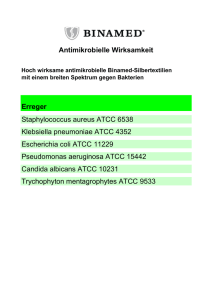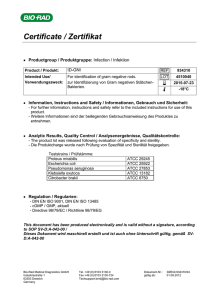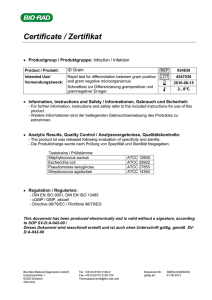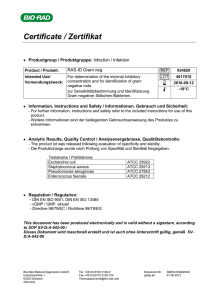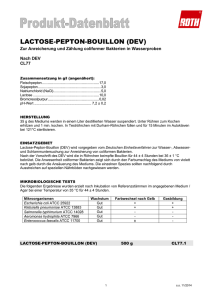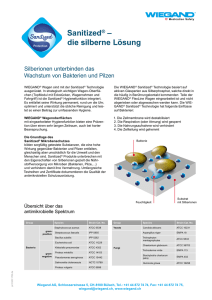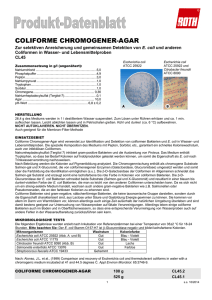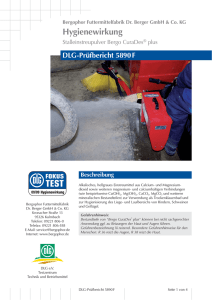BRILLANTGRÜN-GALLE-MEDIUM
Werbung
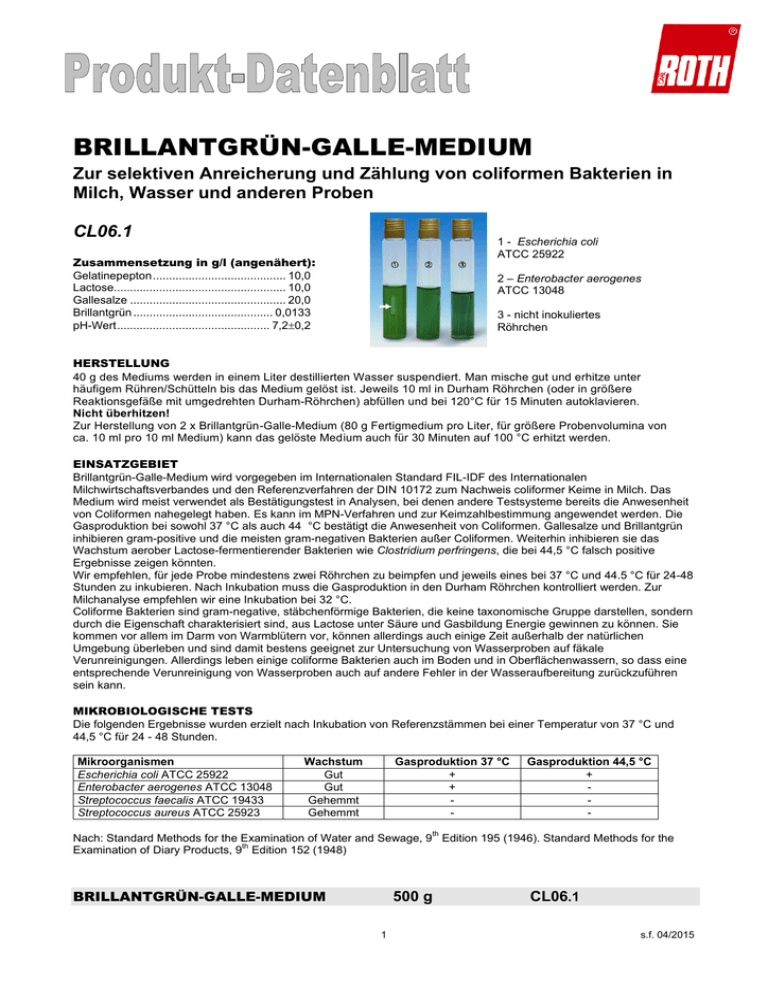
BRILLANTGRÜN-GALLE-MEDIUM Zur selektiven Anreicherung und Zählung von coliformen Bakterien in Milch, Wasser und anderen Proben CL06.1 1 - Escherichia coli ATCC 25922 Zusammensetzung in g/l (angenähert): Gelatinepepton ......................................... 10,0 Lactose..................................................... 10,0 Gallesalze ................................................ 20,0 Brillantgrün ........................................... 0,0133 pH-Wert ............................................... 7,20,2 2 – Enterobacter aerogenes ATCC 13048 3 - nicht inokuliertes Röhrchen HERSTELLUNG 40 g des Mediums werden in einem Liter destillierten Wasser suspendiert. Man mische gut und erhitze unter häufigem Rühren/Schütteln bis das Medium gelöst ist. Jeweils 10 ml in Durham Röhrchen (oder in größere Reaktionsgefäße mit umgedrehten Durham-Röhrchen) abfüllen und bei 120°C für 15 Minuten autoklavieren. Nicht überhitzen! Zur Herstellung von 2 x Brillantgrün-Galle-Medium (80 g Fertigmedium pro Liter, für größere Probenvolumina von ca. 10 ml pro 10 ml Medium) kann das gelöste Medium auch für 30 Minuten auf 100 °C erhitzt werden. EINSATZGEBIET Brillantgrün-Galle-Medium wird vorgegeben im Internationalen Standard FIL-IDF des Internationalen Milchwirtschaftsverbandes und den Referenzverfahren der DIN 10172 zum Nachweis coliformer Keime in Milch. Das Medium wird meist verwendet als Bestätigungstest in Analysen, bei denen andere Testsysteme bereits die Anwesenheit von Coliformen nahegelegt haben. Es kann im MPN-Verfahren und zur Keimzahlbestimmung angewendet werden. Die Gasproduktion bei sowohl 37 °C als auch 44 °C bestätigt die Anwesenheit von Coliformen. Gallesalze und Brillantgrün inhibieren gram-positive und die meisten gram-negativen Bakterien außer Coliformen. Weiterhin inhibieren sie das Wachstum aerober Lactose-fermentierender Bakterien wie Clostridium perfringens, die bei 44,5 °C falsch positive Ergebnisse zeigen könnten. Wir empfehlen, für jede Probe mindestens zwei Röhrchen zu beimpfen und jeweils eines bei 37 °C und 44.5 °C für 24-48 Stunden zu inkubieren. Nach Inkubation muss die Gasproduktion in den Durham Röhrchen kontrolliert werden. Zur Milchanalyse empfehlen wir eine Inkubation bei 32 °C. Coliforme Bakterien sind gram-negative, stäbchenförmige Bakterien, die keine taxonomische Gruppe darstellen, sondern durch die Eigenschaft charakterisiert sind, aus Lactose unter Säure und Gasbildung Energie gewinnen zu können. Sie kommen vor allem im Darm von Warmblütern vor, können allerdings auch einige Zeit außerhalb der natürlichen Umgebung überleben und sind damit bestens geeignet zur Untersuchung von Wasserproben auf fäkale Verunreinigungen. Allerdings leben einige coliforme Bakterien auch im Boden und in Oberflächenwassern, so dass eine entsprechende Verunreinigung von Wasserproben auch auf andere Fehler in der Wasseraufbereitung zurückzuführen sein kann. MIKROBIOLOGISCHE TESTS Die folgenden Ergebnisse wurden erzielt nach Inkubation von Referenzstämmen bei einer Temperatur von 37 °C und 44,5 °C für 24 - 48 Stunden. Mikroorganismen Escherichia coli ATCC 25922 Enterobacter aerogenes ATCC 13048 Streptococcus faecalis ATCC 19433 Streptococcus aureus ATCC 25923 Wachstum Gut Gut Gehemmt Gehemmt Gasproduktion 37 °C + + - Gasproduktion 44,5 °C + - Nach: Standard Methods for the Examination of Water and Sewage, 9th Edition 195 (1946). Standard Methods for the Examination of Diary Products, 9th Edition 152 (1948) BRILLANTGRÜN-GALLE-MEDIUM 500 g 1 CL06.1 s.f. 04/2015 BRILLIANT GREEN BROTH For selective enrichment and enumeration of coliform bacteria in milk, water, and other sample material CL06.1 1 - Escherichia coli ATCC 25922 Approximate formula in g/l: Gelatine peptone ...................................... 10.0 Lactose..................................................... 10.0 Bile salts ................................................... 20.0 Brilliant green ....................................... 0.0133 Final pH ............................................... 7.20.2 2 – Enterobacter aerogenes ATCC 13048 3 – uninoculated vial PREPARATION Suspend 40 g of the medium in one litre of deionised or distilled water. Mix well. Heat with frequent agitation until complete dissolution. Dispense into tubes with Durham gas collecting vials for gas detection and autoclave at 120 °C for 15 min. Do not overheat! For preparation of 2 x Brilliant Green Bile Broth (80 g powder per litre, for larger sample volumina of approx. 10 ml per 10 ml tube) the dissolved medium may also be heated to 100 °C for 30 min. USES Brilliant Green Bile Broth is prescribed by International Standard FIL-IDF of the International Diary Federation and DIN 10172 for detection of coliform microorganisms in milk. It is mainly used as a confirmation test in procedures where presumptive tests for coliforms present are positive. It can be applied with the MPN technique or with the colony-count technique. The production of gas at both 37 °C and 44 °C confirms the presence of coliforms. Ox bile and Brilliant green inhibit gram positive bacteria and most gram negative bacteria except coliforms. They also stop the growth of the aerobic lactose fermenters such as Clostridium perfringens, which could give false positive results at 44.5 °C. We recommend to inocculate at least two tubes for each sample and incubate at 37 °C and 44.5 °C, respectively, for 2448 hours. Then screen for gas production in the Durham tubes. It is recommended to incubate at 32 °C for milk analysis. Coliform bacteria are gram-negative, bacillary bacteria which do not represent a taxonomic group, but are characterized for being able to produce energy from lactose under acid and aerosis. They are prevalent particularly in the intestines of warm-blooded animals. They can, however, survive for a time outside their natural environment and are therefore extremely suitable for analyzing water samples for faecal contamination. However, some types of coliform bacteria do in fact live in the soil and in surface waters with the result that the respective contamination of the water samples may be ascribed to other errors during treatment of water. MICROBIOLOGICAL TEST The following results were obtained from type cultures after incubation at a temperature of 37 °C and 44.5 °C and observed after 24 - 48 hours. Microorganisms Escherichia coli ATCC 25922 Enterobacter aerogenes ATCC 13048 Streptococcus faecalis ATCC 19433 Streptococcus aureus ATCC 25923 Growth Good Good Inhibited Inhibited Gas production (37 °C) + + - Gas production (44,5 °C) + - Acc. to: Standard Methods for the Examination of Water and Sewage, 9th Edition 195 (1946). Standard Methods for the Examination of Diary Products, 9th Edition 152 (1948) Carl Roth GmbH + Co. KG Schoemperlenstraße 3-5 _ 76185 Karlsruhe Postfach 100121 _ 76231 Karlsruhe Telefon: +49 (0) 721/5606-0 Telefax: +49 (0) 721/5606-149 E-Mail: [email protected] _ Internet: www.carlroth.de BRILLIANT GREEN BILE BROTH 500 g CL06.1 2 s.f. 04/2015
